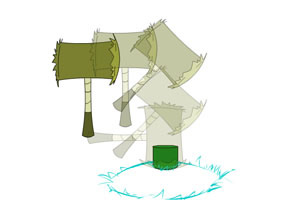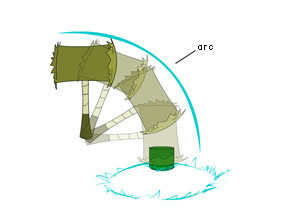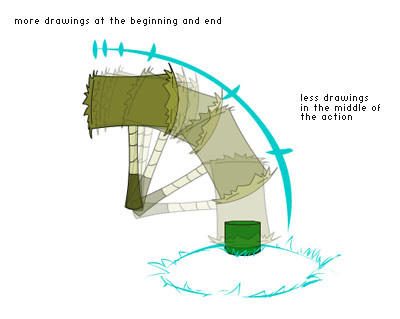by
Daniel Bodinof aka Danielthelion | 10 March 2007
Now that you have a good idea of what we are about to do
from the
previous page, let's begin by discussing arcs of motion.
This concept relates to how things move. More appropriately,
how living, organic, non-mechanic things usually move. Now
while the subject of our animation is a mallet and a button
(man made objects), we can imagine that a human being would
be swinging this mallet to smash in the button. So arcs of
motion refers to how the source of the action moves. Lots of
really old animators would study how people move. What they
found is that most natural motions move along a curved path,
or an arc, not a straight line. Lets onionskin our mallet
and see what kind of arc its moving on:

WOW. That's pretty hideous. The animation lacks any arc
or smooth pattern! I can not stress enough the importance of
using your onionskin to check your arcs of motion when
working in Flash. It is the equivalent of traditional animators page-flipping!
Lets look at the same drawings when they are positioned
correctly to make a nice arc:
If we do an onionskin, notice that now have this nice
looking specimen:

So you can now see that the mallet has a certain pattern to
it. The arc is literal here. It now moves the way it would
if a really old robot was using it, nut that's not good
enough for us. We want LIFE in our animation right? We want
it to look like its being used by a human, (or for you
Battlestar Galactica fans out there) a cylon at the very
least. So lets learn about the next principle, slow-in and
slow-out.
The basic jist of this principle is that we add more
drawings to the beginning and to the end of our sequence. In
essence, the animation slowly moves into the arc, and then
slowly leaves. If you observe how people move, how actions
are made, you'll begin to witness slow in slow out in life.
It all has to do with inertia and gravity where it takes
more effort to begin or end a sequence of movements. Now do
ALL things slow in and slow out? Absolutely not! It's up to
you as an animator to experiment and find out what types of
actions slow in, but don't slow out. Here are a few
examples:
Slow in, but don't slow out
A car driving fast from a distance, but as it passes you, it
whizzes by.
Slow out without slowing in
Someone getting ready to sneeze
Slow in and slow out
Our example here today.
So without further ado, let me show you what I mean:
The following image shows the onionskin for the above
animation:

By adding more drawings at the beginning and ending of the
action, we achieve a more lifelike feel to our animation.
You must experiment with how many drawings any particular
action needs for slow in, slow out. Sometimes, you may only
need one, other times, you might want 5 or 6. Eventually,
you'll develop a feel for how many drawings you'll need.
So now our animation is moving correctly, and it even has a
nice, subtle slow in and slow out. But I don't know, it
still seems to be lacking a certain something. There's still
some room to add more life to our animation! But how? Let's
find the answer in our next (and my favorite) principle,
anticipation.
Onwards to the
next page!
|